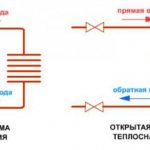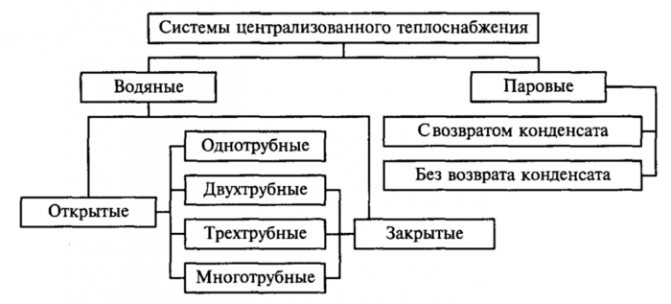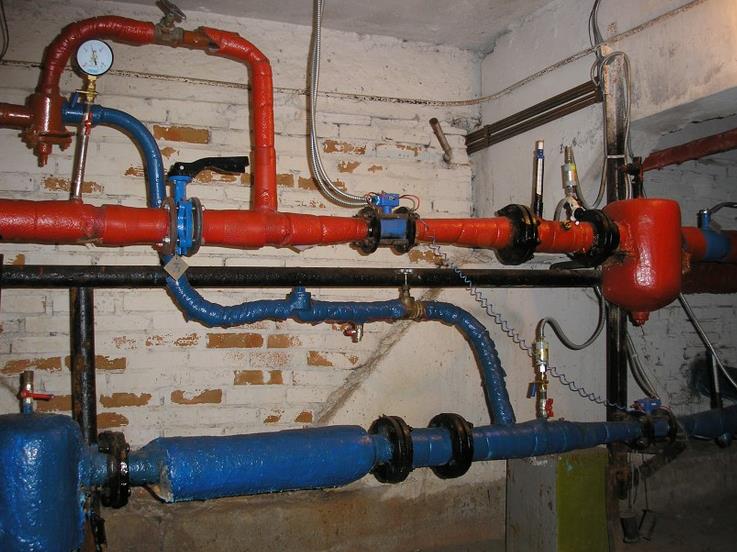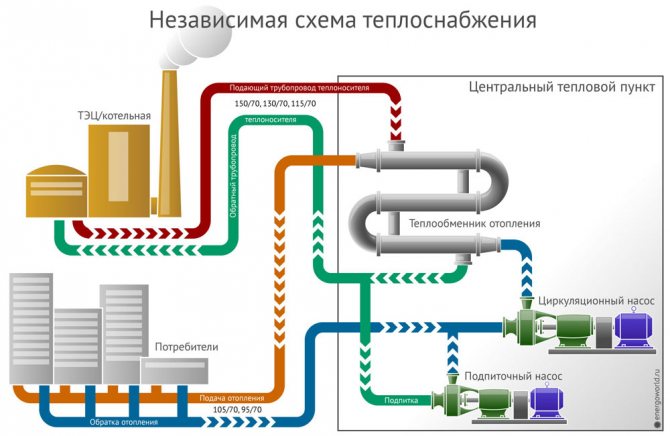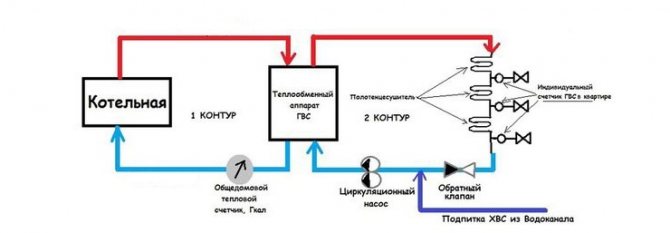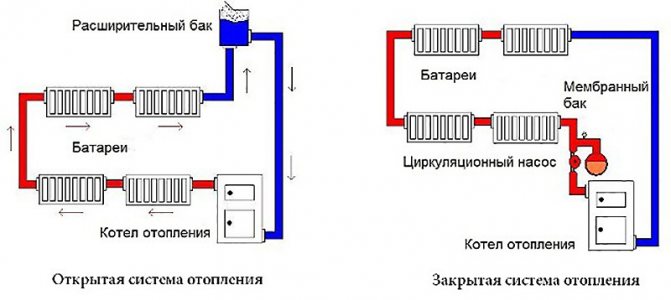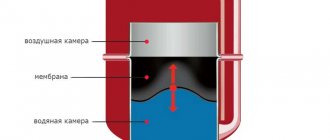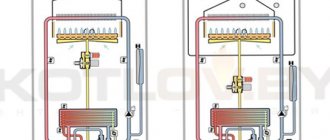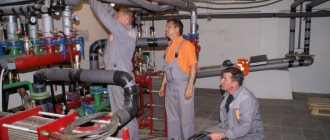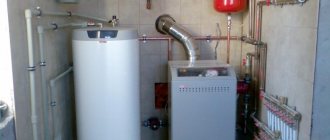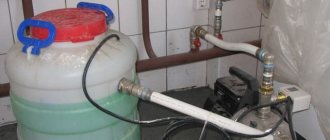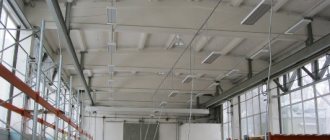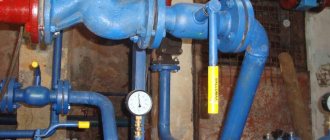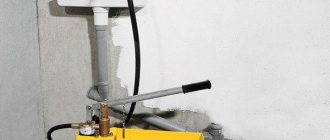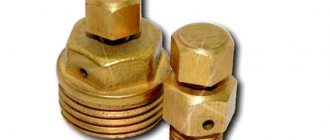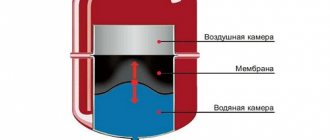For space heating, a closed and open heat supply system is used. The latter option additionally provides the consumer with hot water. At the same time, it is necessary to control the constant replenishment of the system.
A closed system uses water only as a heat carrier. It constantly circulates in a closed loop where losses are minimal.
Any system consists of three main parts:
- heat source: boiler room, CHP, etc .;
- heating networks through which the coolant is transported;
- heat consumers: heaters, radiators.
Features of an open system
The advantage of an open system is its cost effectiveness. Due to the long length of pipelines, the quality of water deteriorates: it becomes cloudy, acquires color, and has an unpleasant odor. Attempts to clean it make it expensive to use.
Heating pipes can be seen in big cities. They have a large diameter and are wrapped in a heat insulator. From them, branches are made to individual houses through a thermal substation. Hot water is supplied for use and to the heating radiators from a common source. Its temperature ranges from 50-75 ° C.
The connection of heat supply to the network is carried out in dependent and independent ways that implement closed and open heat supply systems. The first is to supply water directly - using pumps and elevator units, where it is brought to the required temperature by mixing with cold water. An independent method is to supply hot water through a heat exchanger. It is more expensive, but the consumer's water quality is higher.
Features of a closed system
The heat line is made in the form of a separate closed loop. The water in it is heated through heat exchangers from the CHP mains. Additional pumps are required here. The temperature regime is more stable, and the water is better. It remains in the system and is not taken away by the consumer. Minimal water losses are recovered by automatic replenishment.
A closed autonomous system receives energy from the heat carrier supplied to the heating points. There the water is brought to the required parameters. For heating systems and hot water supply, different temperature regimes are supported.
The disadvantage of the system is the complexity of the water treatment process. It is also expensive to deliver water to substations located far from each other.
Elements of the compulsory system
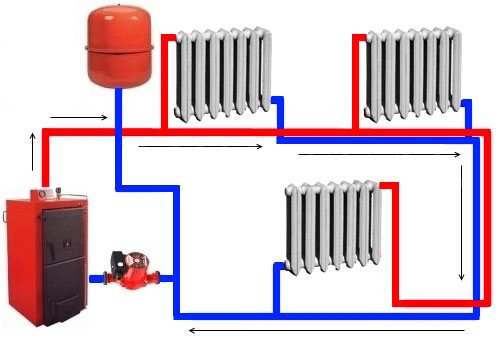
Closed expansion tank
The expansion tank can be open or closed (expansomat). A closed system with a compensator is used more often, since water evaporates in an open circuit. In such a system, atmospheric oxygen enters and leads to corrosion of internal steel parts.
Elements of the heating system of a private house with forced circulation:
- boiler for gas, solid or liquid fuel;
- membrane expansion tank;
- circulation pump of appropriate capacity;
- batteries;
- pipes;
- connections and adapters;
- valves for various purposes, taps;
- air vents;
- filters;
- fasteners.
The pumping equipment must ensure the movement of the energy carrier, therefore, it is selected according to power. An excessively strong pump creates additional noise and wastes electricity.
In a closed line, a safety group is provided, which is placed at the outlet of the supply line from the heating unit.It coordinates pressure and relieves excess pressure in an emergency, and normally removes air from the pipeline.
Heating pipes
At present, domestic heating networks are in an emergency condition. Due to the high wear and tear of communications, it is cheaper to replace pipes for heating mains with new ones than to engage in permanent repairs.
It is impossible to immediately renew all the old communications in the country. During the construction or overhaul of houses, new pipes are installed in polyurethane foam insulation (PPU), which several times reduce heat losses. Pipes for heating mains are made using a special technology, filling the gap between the steel pipe located inside and the shell with foam.
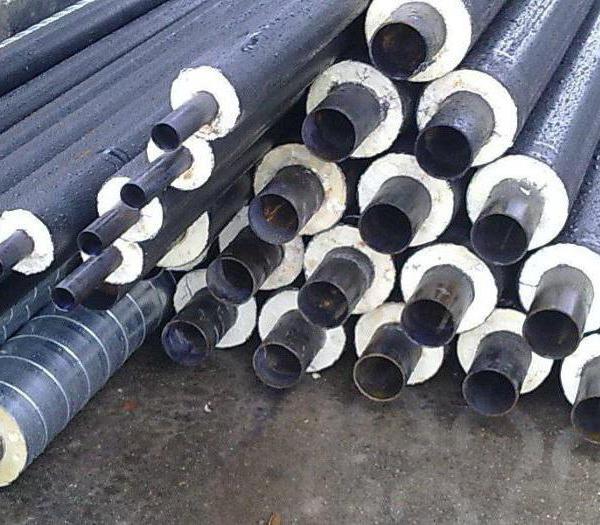

The temperature of the transported liquid can reach 140 ° C.
The use of polyurethane foam as thermal insulation allows you to keep heat much better than traditional protective materials.
Heat supply for multi-apartment residential buildings
Unlike a summer cottage or a cottage, the heat supply of an apartment building contains a complex layout of pipes and heaters. In addition, the system includes controls and security.
For residential premises, there are heating standards, which indicate critical temperature levels and permissible errors, depending on the season, weather and time of day. If we compare a closed and open heating system, the former better maintains the necessary parameters.
Public heat supply must ensure the maintenance of the basic parameters in accordance with GOST 30494-96.
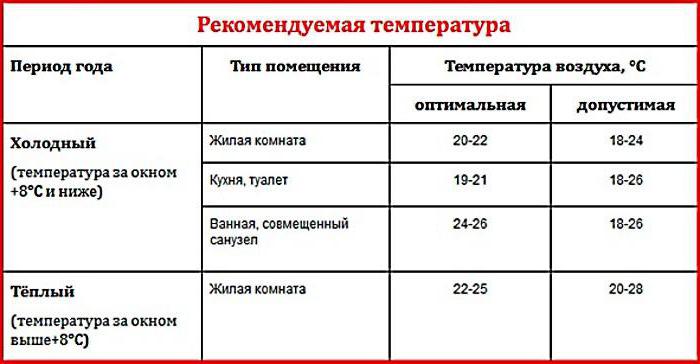

The greatest heat losses occur in the stairwells of residential buildings.
Most of the heat supply is carried out according to old technologies. Essentially, heating and cooling systems should be combined into a common complex.
The disadvantages of district heating in residential buildings lead to the need to create individual systems. This is difficult to do due to problems at the legislative level.
Five questions about open and closed heating systems
Question number 5. Is it worth building a garden at all?
The big question is, is it necessary to go to such costs at all? Head of the Department of Heat and Gas Supply and Ventilation, Ulyanovsk State Technical University, Doctor of Technical Sciences and professor Vladimir Sharapov
I am sure that those who advocate the elimination of open systems simply have a poor understanding of the basics of CHP and heating systems in general: “Firstly, open heat supply systems, in contrast to closed ones, make it possible to maximize the effect of combined generation of electric and thermal energy due to the use of low-grade heat sources (including the exhaust steam of the turbines) for heating large amounts of make-up water of the heating network at the CHPP ”. As an example, the professor cites the Yuzhnaya CHPP in St. Petersburg, where, when the system is closed, the annual excess consumption of fuel can exceed 100 thousand tons of fuel equivalent!
Sharapov is also confident that open systems are still capable of maintaining a high quality of network water in all systems "due to the possibility of highly efficient centralized anti-scale and anti-corrosion treatment of make-up water at CHPPs." And that they are generally "more reliable than closed systems in sanitary and epidemiological terms", since "the complete tightness of closed systems should be considered a myth."
“In theory, the separation of the circuits should not only ensure the supply of hot water to the consumer with the parameters required by sanitary standards, but also reduce the damage to heating networks by improving the quality of the network water. In practice, however, these expected improvements are usually not achieved.The fact is that there are no ideal systems, and the most important elements of closed systems - hot water heaters - have leaks through which cold tap water flows into the heating network and back. Thus, the expected benefits of a closed system are not realized. In the first case, water from the cold water supply system enters the heating network, which has not undergone the preparation (deaeration) necessary for heating networks, as a result, the corrosion rate increases. According to the available data, the intensity of internal corrosion in open and closed systems is approximately the same. And in the second case (when water from the heating network enters the hot water system through leaks), the quality of hot water will be worse than in an open system, since the consumer will be supplied with water that does not meet drinking water standards, "explains the Deputy Director of the Heat Division of SGK on perspective development Alexander Grigoriev
.
“It is known that the goal of switching to closed DHW systems is to improve the quality of hot water and the quality of heat supply. But in St. Petersburg, for example, the quality of hot water meets the standards. The advantages of a closed DHW system are not disputed - this is saving on heat losses when hot water moves along heating mains, plus the risk of accidents on heating mains is reduced, which often happens in St. Petersburg. However, the costs of translation are colossal and their expediency requires additional discussion, "the senator is sure Andrey Kutepov
.
One way or another, but so far it will not be possible to fulfill the current requirement of the law - time is lost, the train has left. This means that it is worth finally "lowering" the projects to the ground and giving the local specialists the right to decide for themselves which water supply to use. “It is important to study the experience of the leaders - how did they manage to cope with such a difficult task in the conditions of limited resources and curbing the growth of tariffs? Educational programs for municipalities and regions will be useful. The automatic shift of the normative deadlines for the "closure" of open systems to the right is a much simpler way, but definitely demotivating, "says Yuri Melnikov
... But so far, apparently, the only possible one.
Autonomous heat supply of a residential building
In buildings of the old type, according to the project, a centralized system is provided. Individual schemes allow you to choose the types of heat supply systems in terms of reducing energy costs. Here there is the possibility of their mobile shutdown if not needed.
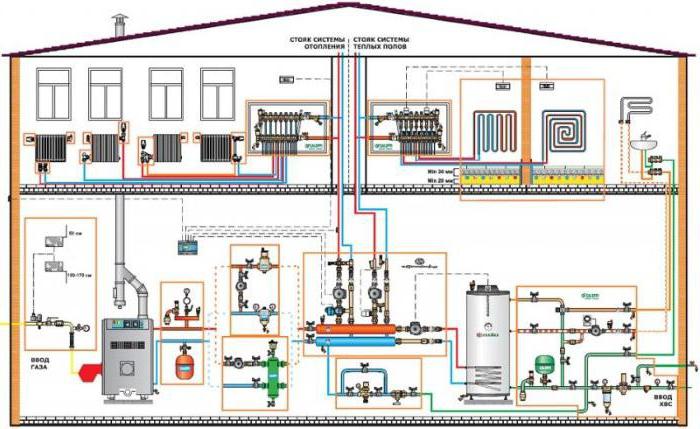

The design of autonomous systems is carried out taking into account the heating standards. Without this, the house cannot be commissioned. Compliance with the standards guarantees comfort for the residents of the house.
The source of heating water is usually a gas or electric boiler. You must select a method for flushing the system. In centralized systems, the hydrodynamic method is used. For stand-alone you can use chemical. In this case, it is necessary to take into account the safety of the influence of reagents on radiators and pipes.
The role of a circulation pump for heating a private house
In order to visually assess the role of the circulation pump in the heating circuit, it is worth listing the main advantages of its installation:
- A heating circuit with a pump is easier to install because it is not required to observe the angle of inclination of the pipes, which is mandatory for hydraulic circuits
- Let's admit a smaller pipe diameter, because the pump will easily provide forced flow of the coolant
- There are no restrictions when buying a radiator of any design, forced circulation in the heating system will overcome the resistance of their narrow sections
- Due to narrow pipes, the interior of the room looks neater, the wiring is easier to hide
- The pipeline is not limited in length, as is the case with the natural flow of water along the contour
- The ability to make a manifold wiring
- Thanks to the pump, it is possible to install "warm floors" in the house
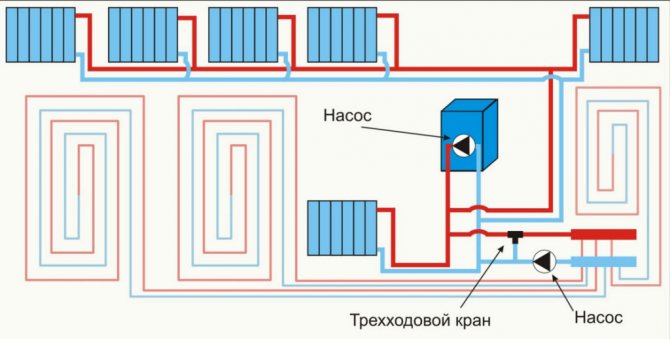

You can't do without a circulation pump, this is a nuance of the system
Legal framework for relations in the field of heat supply
The relationship between energy companies and consumers is regulated by the Federal Law on Heat Supply No. 190, which came into force in 2010.
- Chapter 1 sets out the basic concepts and general provisions that determine the scope of the legal foundations of economic relations in heat supply. It also includes hot water supply. The general principles of organizing heat supply are approved, which consist in creating reliable, efficient and developing systems, which is very important for living in the difficult Russian climate.
- Chapters 2 and 3 reflect the broad scope of powers of local authorities that manage pricing in the field of heat supply, approve the rules for its organization, accounting for heat energy consumption and standards for its losses during transmission. The completeness of power in these matters allows you to control the heat supply organizations related to monopolists.
- Chapter 4 reflects the relationship between the heat supplier and the consumer on the basis of the contract. All legal aspects of connection to heating networks are considered.
- Chapter 5 reflects the rules for preparing for the heating season and repairing heating networks and sources. It describes what to do in case of non-payments under the contract and unauthorized connections to heating networks.
- Chapter 6 defines the conditions for the transition of an organization to the status of self-regulatory in the field of heat supply, the organization of the transfer of rights to own and use the heat supply object.
Heat users must know the provisions of the Federal Law on heat supply in order to defend their legal rights.


Drawing up a heat supply scheme
The heat supply scheme is a pre-project document, which reflects the legal relations, the conditions for the functioning and development of the heat supply system for the urban district, settlement. In relation to it, the federal law includes certain norms.
- Heat supply schemes for settlements are approved by the executive authorities or local self-government bodies, depending on the size of the population.
- There must be a single heat supply organization for the corresponding territory.
- The diagram indicates energy sources with an indication of their main parameters (load, work schedules, etc.) and the radius of action.
- The measures for the development of the heat supply system, the conservation of excess capacity, the creation of conditions for its uninterrupted operation are indicated.


Heat supply facilities are located within the boundaries of the settlement in accordance with the approved scheme.
Independent organization of the heating system
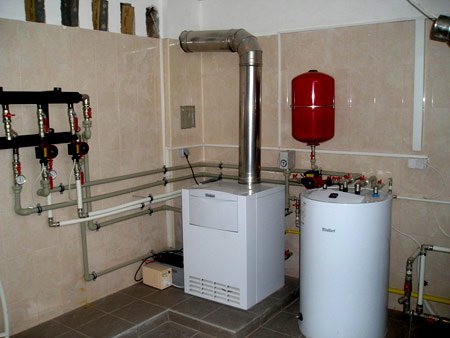

Boiler room arrangement
A good and high-quality heating option can be made with your own hands, taking into account the costs of design, the purchase of equipment and the complexity of the organization. The best option for a private house would be a closed type of communications with a circulation pump and tanks. Its creation is carried out as follows:
- Calculations of communications. Ordered from a design company or produced using an online calculator.
- Coordination of the project, obtaining permission and technical conditions.
- Purchase of equipment. You will need a heating boiler, a pump, pipes, an expansion tank, radiators (circuits, if a warm floor is planned), air vents, shut-off devices, automatic controllers.
- Boiler installation and boiler room equipment. A high-quality ventilation is organized in the room, a chimney is equipped. Walls, floor and ceiling surfaces are sheathed with fire-resistant materials.
- Installation of a circulation pump, distribution manifold and metering devices.
- Lining of the pipeline to the points of the location of the batteries.
- Installation of radiators.
- System pressure testing. The first launch is carried out in the presence of specialists.
The collector circuit is difficult to install and is expensive, but due to the adjustment of the contours, the living conditions in the room will be comfortable.
There are several differences between open and closed heat supply lines. It is worth choosing a heating system depending on the conditions and place of installation. An open highway is easy to organize yourself. Specialists should create a closed system.
